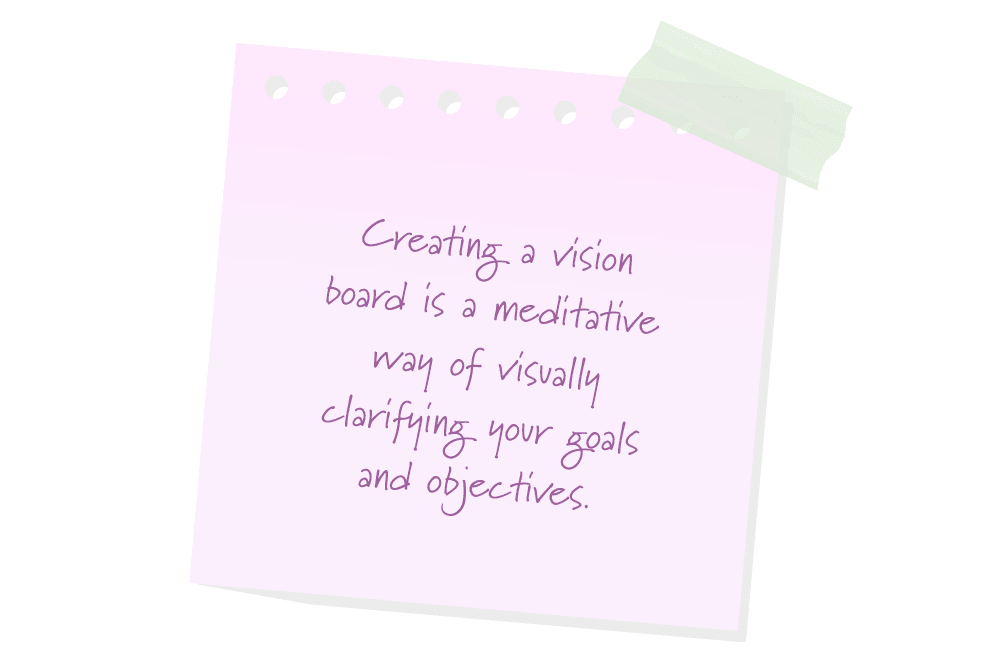
I've been committed to making vision boards for more than 15 years. In fact, as a leadership consultant and coach, I often recommend the practice to my clients.
If you aren’t familiar with the term, a vision board is a collage made up of images, photos, quotes, affirmations, or anything that visually represents your goals, hopes, and dreams for the future.
I should clarify that vision boards are not magic; therefore, I do not create vision boards for magic-manifesting reasons. And I certainly am not convinced that if you think positively, then positive things will automatically happen to you. That said, a vision board is a powerful tool, one that can be used not just for planning the year ahead, but also for brainstorming major projects, solidifying book concepts, and yes, even mapping out keynotes and speeches.
Creating a vision board is a meditative way of visually clarifying your goals and objectives. Making one requires a certain amount of focus and concentration—it’s not something that can be done in 30 seconds or a few minutes, it takes a bit of time. And when we focus and concentrate in a meditative way on what we want for ourselves, we begin to work toward our goals, both subconsciously and consciously.
The Brain and Visualization
There’s science behind why vision boards work. Neuroscientist, medical doctor, and executive advisor Tara Swart is an advocate for using vision boards as a tool, and explains that when done correctly, they “prime the brain to grasp opportunities that otherwise may go unnoticed.”
Even more impressively, Swart maintains, “to the brain, there is little difference between a strongly imagined vision and the actual experience of the thing happening.” According to experts at the professional therapy organization BetterHelp, not only does visualization help alter our brain’s pathways, it can actually help forge new connections that could be beneficial to making our desired outcome a reality.
Plus, did I mention that creating a vision board is meditative?
So, the next time you have an idea, project, or speech and find yourself a bit overwhelmed or unclear on the steps to take to make it happen, consider creating a vision board.
While there are many online platforms that allow you to create a vision board in a way that is both easy and convenient—such as Pinterest or Canva—I’ve always found that the tactile experience of putting one together by hand feels far more mindful and meaningful. Let’s dive in and examine how to create one.
Gather Some Supplies
You’ll want to have everything on hand ahead of time so once your ideas get rolling, you can dive in.
- A stack of old magazines, catalogs, or even old books with illustrations. It’s a good idea to get as many different types of magazines as you can, with images that relate to your hobbies, or travel, or fashion, or business—whatever inspires you. But remember, you’ll be cutting out the words and images, so make sure you’re using publications you don’t mind destroying. Check thrift stores, library sales, yard sales, and other similar places for these types of materials—even the pamphlets and print ads you receive in your mailbox.
- A flat surface. A poster board, a cork board, a magnetic bulletin board, or even a manila folder or journal opened flat—they all work as the basis of a vision board. Whatever you decide to use, make sure there’s enough space to add many images to its surface.
- A pair of scissors. Note: This is optional—I’ve neatly torn out images in a pinch!
- Some sort of adhesive. This can be glue, tape, pushpins, magnets—whatever adhesive is appropriate for the board surface you’ve chosen.

Start Building
Once you have everything you need, it’s time for the fun part.
1.
Spend some time visualizing your project. What are you trying to accomplish—a great year ahead? A successful project? A promotion? A specific goal? What is your ideal outcome and what might that outcome look like once you’ve achieved it—can you describe it in detail? How will it feel taking the steps to make that outcome happen—will you feel strong? Capable? And how will you feel once you’ve successfully completed your project or goal—confident? Powerful? Leveled up?
2.
As you think of the answers to these questions, go through each page of your magazines and catalogs, and cut out any images, words, or phrases that feel reflective of those answers. Don’t overanalyze the significance of each image or worry about collecting too many. For now, simply gather as many images as you can. Your images don’t have to be literal. This isn’t a purely intellectual exercise; it can also be an emotional one. For example, if the image is a picture of a Porsche sports car, you might choose it because of how the image makes you feel (e.g., empowered, exhilarated, wealthy), not just because hey-owning-a-Porsche-might-be-cool.
3.
After you’ve exhausted your magazines and catalogs, take your stack of images and arrange them on your flat surface. There’s no wrong way to do this: Arrange the images in a grid, or straight lines, or overlapping manner—however you’d like. Start with your favorite images—the ones that feel like they encapsulate exactly what you’ve envisioned—and then build off those with your other images. Once you like how your images are arranged, grab your adhesive and affix them to your board.
4.
Examine your board (optional). When you’ve finished placing your images, grab some sticky notes or scraps of paper and jot down any thoughts that come to you as you look at your board. For instance, how do you feel when you look at it as a whole? Are you excited? Inspired?
Once you've finished building your board, take a moment to consider what steps you have already taken that make you feel like you’ve started moving in the right direction—for example, what lessons have your past successes taught you that you could use in the pursuit of this current goal? What experiences have you had that feel relevant to this new pursuit? What friends and connections do you have who can support you? Identifying these resources will show you that you’re not starting from ground zero—you’re already on your way.
Next, consider what steps immediately come to mind to bring what you've visualized to fruition. Write each individual thought on each slip of paper, and if any feel meaningful, add them to your board as well.
Finally, celebrate! Place your vision board where you can access it easily. For some of you, you might love what you’ve created and don’t care if other people see it too, so you’ll hang it somewhere prominent. For others, your vision board may feel very private, so maybe you’ll hang it at the back of your closet behind your clothes so no one can see it—but you can still part your clothes and look at it whenever you want. For those of you who used a manila folder, perhaps you’ll keep it in a file cabinet at work, to pull out whenever you need to look at it.
But the point is to look at it. Frequently. Do this not only for the board to have its scientific visualization effects, but mostly because looking at the images should inspire tangible steps toward your goal. When this happens, add those steps to your daily to-do lists.
And then, over time, watch the magic that you create.
Karen Walrond is a leadership consultant, attorney, speaker, and author of The Lightmaker’s Manifesto: How to Work for Change Without Losing Your Joy. She is trained in positive psychology coaching with the Wholebeing Institute and helps her clients discover their strengths, develop their leadership skills, and use them in a way that allows them to thrive. Learn more at chookooloonks.com.
Related Articles

Personal Growth
Meet Your Future Self—Today

Goal Setting
Set Yourself Up for A Successful Year

Personal Growth



 Previous
Previous

 Previous Article
Previous Article